Patrick A. Trottier (PT)
Emergent Organizational Development and Emergent Change® (EODC®) , Emergent Organizational Development® (EOD®) and Emergent Change® are under registered trademark, 2017. We expect that everyone be respectful enough to use the registered trademark (®) for the former phrases, and their short abbreviations. All writings are considered under copyright as per The Institute For Emergent Organizational Development and Emergent Change®, Patrick Trottier and Associates. Written permission is required.(The Paris Convention for the Protection of Industrial Property. As of January 2019, the Convention has 177 contracting member countries). More information at bottom of this page.
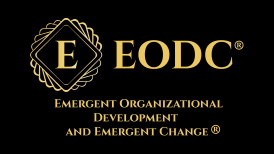
The Institute Of Emergent Organizational Development and Emergent Change® (EODC®)
To begin…
Everything on this site is constantly emerging, as everything naturally does… Patrick Trottier, May 19, 2012.

Welcome.
My objective on this site is to create an understanding regarding ‘Emergent Change®’, and to begin to describe a framework and platform for the practice of Emergent Organizational Development® (EOD®). Patrick A. Trottier
A little about myself:
I am a 40 plus year applied, ‘in-the trenches’ practitioner of fundamental Organizational Development (OD) and Emergent OD®. I continue to learn from my clients and my experiences.
In my academic, undergraduate studies of psychology, I first focused on the individual attributes such as personality, motivation, cognition, and neuroscience (what makes a person feel, think and develop), then I focused on the study of group processes and dynamics. During my graduate work relating to my Masters of Science in Industrial-Organizational Psychology, I focused on organizational design, processes, dynamics, power variables, communication and such.
I come from an industrial labour background (factories, steel mills) where I learned much from that ‘world’ about people and organizations – especially the world of ‘Taylorism’ and hierarchies of which most organizations today are still designed and built from.
In my youth, I was a ‘traveller’ to many countries around the world to ‘just be there’ to experience many different cultures, human diversity, human commonality, and human nature. Those backgrounds were and still are the foundations for my real education about human dynamics, and organizational cultures.
Thus, a keen curiosity about the ‘work world’ and ‘human nature’ linked to a formal education offered me many opportunities to co-create positive differences with individuals, organizations, families and their communities. This, to my surprise, has occurred. I really like when a positive ripple effect emerges into something bigger than itself.
Check out Linked-In where there is a list of the many organizations I have worked with over the last 40 plus years. However, enough said about me. Lets get back to Emergent Organizational Development and Emergent Change® (EODC®)
The Purpose of Emergent Organizational Development®
Simply, the practice of Emergent Organizational Development® is “to design and create organizations to naturally manifest a Living Culture™, a Living Vision™ and emergent, continuous transforming which then, as a whole organization, naturally evolves as a component / influencer of ‘change’ itself.” (EODC®)
Thus, as the realization of the dynamics of ‘change’ emerges the understanding that change is not a separate entity from an organization. An organization IS ‘change’ where such is a natural, inherent aptitude of any organization.
The purpose of these writings is to create and describe:
- An overall ‘Introduction’ to the concepts, ideas and processes of Emergent Organizational Development® (EOD®).
- A number of ‘subject write-ups’ relevant to Emergent Change® and EOD®. (see upper menu and along right column)
- The basic ‘principles and concepts’ to Emergent Change® and EODC®.
- An ’emergent vocabulary’ as seen in ‘Key Emergent Phrases / Terms’ (see menu above).
- The ‘conditions’ that influence and manifest the ability to influence and shape natural, emergent change in people and organizations.
- An applied methodology / approach to Emergent Organizational Development® as per The EODC® Platform to create ’emergent organizations’: https://goo.gl/7jiOo4
- A more ‘in-depth’ description rests here: https://emergentchange.net/2018/02/27/the-emergent-organizational-development-and-change-eodc-platform/
A little of EOD® history.
My passion in ’emergent change’ started in the mid-1990s consulting with my San Francisco municipality and S.F. Bay area clients that stemmed from financial organizations looking at fast regulatory change and shifting customer service expectations, municipalities that were facing rapid growth migration as well as a huge culture diversity mix in their new citizens, and IT companies that were still experiencing rapid evolution in their technology applications, new challenges within their own organizations and serious competitors rising up almost every day.
During this time, I began to notice that ‘change’ happened every day, that change seemed natural and constant, that change had its ebb and flows. I also observed that the approaches to ‘managing change’ were cumbersome processes of ‘planned change’ or ‘event change’ initiatives focused on the future, or the past, while real change was happening in the present.
I also noticed that the effort to change the organization was some ‘special project’ with a lot of extra effort and fanfare outside of the business of the business itself, and normal every day work.
I started to explore, and to ask myself questions.
Maybe we need to think differently about change itself?
- Maybe we have to think differently about change – a different mental and emotional framework?
- Maybe we have to understand the dynamics of change before we can better influence, move with, or adapt to change?
- Maybe we need a different vocabulary about change itself? Words influence and convey how we ‘see’ things. How we ‘see’ things is what we create. (https://globaltransforming.wordpress.com/key-emergent-phrases-terms)
- Maybe we need to move from our traditional thinking of ‘change’ to some thing else, that entails a different set of attributes, styles and competencies for the leadership of people and organizations?
- Maybe in shifting our thinking about ‘change’, we will shift our thinking about OD for the 21st Century? Thus, EOD® started its journey.
This questions go to the heart of our work in developing the framework and platform in regards to an Emergent Organizational Development and Change (EODC)® approach.
In the early 2000s colleagues and clients encouraged me to write about my ideas, concepts, principles and applied approaches. This is what encapsulates this site. I continue to practice and mentor others in Emergent OD®
Thus, formal EOD® started its journey.
What Is Emergent Organizational Development and Change (EODC)®?
We know that organizations today are facing a significant increase in the rate of change and face greater complexities in the issues, opportunities and challenges as regional and global growth continue. We know that even greater ‘disruptors’ to normal life and normal organizational procedures and practices will be experienced. In addition, disruptors such as COVID, climate change, limited resources of food and materials, novel technologies, and changing global economic and social patterns call for innovative 21st Century types and forms of organizations.

The purpose of Emergent Organizational Development and Change (EODC)® is to help create the conditions for organizations to conquer the complexities and the rates of change in the 21st Century.
EODC® can be simply understood as setting up the conditions within an organization so emergent change becomes apparent and influenced more fluidly, naturally and is viewed and experienced as a normal, continuous, real-time process.
Since the 1980s, I have always described Organizational Development as a ‘business strategy’ and as the ‘ways and means’ embedded within the fabric of an organization to manifest its business goals and culture, which are entwined within a systemic relationship. This fundamental idea also has evolved and carries on within the processes of Emergent OD®
A colleague, Edward Hampton, Managing Member, Performance Perspectives LLC states it well;
“Position OD work on the emergent. Past OD work has looked to the Past and/or to the Future. Those were boxes. The emergent is where Flow operates. It is where the client lives – and dies. OD consultants need to work there.”
The Emergent Organizational Development (EOD®) Platform and Framework is constantly forming and being shaped out of the following theorems, constructs, research and practices of:
- The Fundamentals of Organizational Development and Emergent Organizational Development®.
- The Dynamics of ‘Emergent Change’.
- Chaos Theory. “Out of chaos emerges form.” (Patrick Trottier, 2012)
- Complexity Theory. “Out of complexity emerges simplicity through form.” (Patrick Trottier, 2012)
- Process and Emergent Consultation approaches.
- Human Development and Naturalism.
- Behavioral Science
- Neuropsychology.
- Emergent business systems and processes.
- Emergent Organizational Design – integrated, collaborative, value streaming network forms.
- Technology: InfoHumanics©; IT/IS/AI information technology systems and processes designed to support, augment and facilitate human information processing and the ‘human experience‘. Marked by humanistic values, and a devotion to human and our planet’s well being. Human performance centered. (P.Trottier, 2013)
A few concepts (EODC)® embraces:
For emergent change to become apparent and continually influenced and shaped, an organization needs to create the ‘conditions’ for such to occur, and embrace ideas such as…
- People are naturally experiential; that is, people create their perceptions, beliefs and assumption through their experiences.
- Change occurs in ‘real-time’
- “Out of chaos emerges form” (Trottier, 2015)
- “Out of complexity emerges simplicity through form” (Trottier, 2015)
- People are naturally ‘self-organizing agents’.
- People have a natural curiosity for exploration, discovery and the unknown.
- People have a natural sense to collaborate more often than not depending on conditions experienced.
- Change is natural to people depending on the degree of impact, and the degree of their control and influence in how change occurs.
- Open, integrated IT/IS system designs and information streams are fundamental and integral to emergent change and creating emergent, adaptive, fluid organizations.
- Adapting new ways of thinking such as ‘pattern thinking’, and ‘systemic thinking’.
- Emergent Action Research™ (EAR™) is a fundamental OD process of EODC®.
- One must view an organization and a person as a ‘whole, dynamic, systemic entity’ in relation to its / one’s environments’.
- For the most part, natural human attributes related to emergent change and enhanced performance are depleted by our current social norms, educational practices, institutionalization, organizational structures, systems / process designs and work environments.
- People, need to understand change itself, before one can better influence, move with, or flow with change.
- The manifestation of ‘Self-Agency’ is paramount in organizations.
For a larger list of initial EODC® ‘principles’, please go to the top menu; (this list is emerging…)
‘Some Basic Principles For An Emergent Organizational Development and Change (EODC)® Platform’
Again, EODC® can be simply understood as setting up the conditions within an organization so emergent change becomes apparent and influenced more fluidly, naturally and is viewed and experienced as a normal, continuous, real-time process.
On Change Itself
‘Change is constant… with different rates, patterns and forms.’ (vs. ‘a constant’)
‘Change is natural…’
‘Change changes…’
‘Change exists only in the present…’
‘ Change is experienced differently…’
A few examples:


Levels and Scope Of Emergent Organizational Development and Change®
EODC® views that there are three prevalent levels of change occurring in organizations today. Each type calls for very different change strategies, change methodologies, and change leadership mindsets.
1. Continuous Improvement Change and Development – To improve effectiveness, efficiency and innovative improvement aligned to current critical success factors and strategic focus. Stay the course, increase performance to achieve business results. (incremental change as a continuous, emergent process…)
2. Transitional Change and Development – Integrated Organizational Alignment. To integrate and align the organization to its business model, culture, emerging strategic directions, and operational business goals.(embeds 1) (transitional change as a continuous emergent process…)
3. Emergent Transformational Change and Development – Emerging organizational ‘forms’ designed to naturally manifest a living culture that naturally evolves as a component / influencer of ‘change’ itself. (embeds 1, 2) (transformation as a continuous, emergent process…)
What is ’emergent change’?
“Emergent” and “emergence” refers to the state of being in continual process – always in transition / transformation.
Change itself is constant with various with different rates, forms and scope (vs. ‘a constant’).
“Emergent change is based on the shaping of continuous ‘forms’ by internal and external influencing patterns and determinates. That which emerges may be further shaped into further continually evolving patterns.” (P. Trottier, 1995)
The following diagram tries to show how ‘attractors / ‘realtors’ may, or may not, continually move through stages of ‘relationships’ and ‘density of such relationships’ which may eventually construct into emerging forms.
Attractors / Relators – elements that form some degree of relationship with other elements. Such may or may not be apparent, or form into ‘trends’.
To view larger image, right click – ‘view image’.
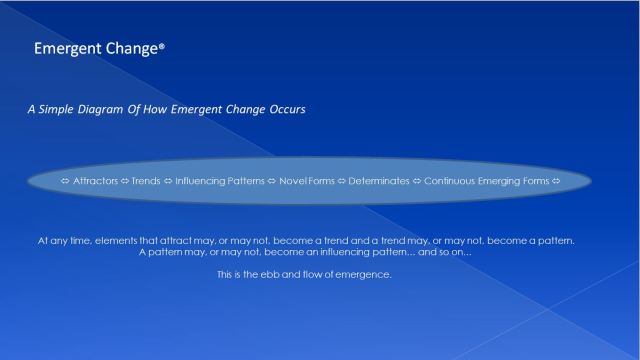

At any time elements that attract / relate may, or may not, become a trend and a trend may,
or may not, become a pattern.
A pattern may, or may not, become an influencing pattern… and so on…
What may become, and what may not become depends on three things:
1. Relationship,
2. Density of that relationship, and
3. Tipping point.
This is the ebb and flow of emergence.
This applies to the forming of individuals, groups, organizations, the forming of nature, the forming of stars, planets… well, everything…
===================
‘Forms’; an arrangement of patterns, attributes and/or elements defined within flexible, porous, adaptable characteristics and parameters. ‘Form’ lives within a particular functioning condition in which something is manifested.
With ‘organizational designs’ we use the term ‘form’ which is more open, flexible and adaptive to changing environments than the traditional term ‘structure’, which we see as more static, inflexible and restrictive to changing environments.
What Are Emergent Organizations?
When we refer to organizations as emergent, we are saying that every facet of organizations such as culture, ‘form’, vision, strategies, people, technology, social relationships, decision making processes as well as business systems and processes are continually changing, following no exact predefined, prescribed, predictable pattern. These ‘organizational forms’ are products of constant social negotiation with their internal and eternal environments, influencing patterns and determinates.
By the term ‘form’, we are NOT limiting ‘organizational form’ to such an old term such as ‘structure’. We are talking about ‘a whole system’ which includes behaviors, perceptions, capabilities, norms, finances, policies, practices, technologies, relationships, environmental influences, systems, structures, compensation , rewards, decision-making processes, power dynamics, etc., etc., and some may call this a systemic, synergistic ‘gestalt.’.
“The organization itself, or any of its features, may exhibit temporal regularities. But such temporal regularities are recognizable only by hindsight and at a moment in time, because organizations are always in process; they are never fully formed.” (1.)
“Organizational emergence holds the theory that organizations do not assume that stable structures, systems and processes underpin organizations.“(1.)
Is there ever a need for predictability and standardization?
Yes, it must be noted that some operational forms need to be predictable based on prescribed criteria of standardization and such can be quite appropriate. We can see this in policy that governs liability and regulated procedures as in banking systems, governmental legal mandates and procedures, as well as in insurance systems. Although such mandates, law and policies create structure and forms to standardize process and outcome, elements like mandates, laws and policies can and do themselves emerge and evolve. Ipso facto, when this change occurs the standardized procedures themselves change and evolve.
We can also see examples for the need for predictability and standardization in automated assembly lines to produce higher quality products and service administration and management at greater rates of efficiency and effectiveness. Robotics work within certain parameters of acceptable criteria of decision-making and behavior through AI programming incorporated into business systems and process applications through intelligent agent/ AI algorithms.
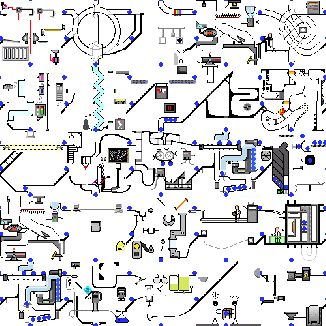
All quite appropriate to achieve such things as economy of scale, management of liability and predictive business strategies.
The question here is: Do traditionally structured organizations of ‘managed control’ fit well with current business environments of rapid change, chaos, uncertainties and the increasing complexity of issues, challenges and opportunities?
Question:
However, how well can this ⇓ manage and control…. this ⇓ ??
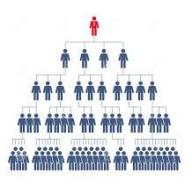
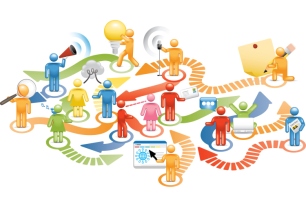
On Emergence, Form And Purpose
“The manifestation of form is naturally inherent in the processes of ‘emergent change’ .
This is the primaeval nature of emergent change itself” (Patrick A. Trottier, 2016)
“Emergence manifests form to manifest purpose.” (Patrick Trottier, Edward Hampton, March, 2017)
“Form continually defines itself as a self-organizing agent, and through such manifests purpose. Without form, the nature of emergent change is to continually strive to manifest and evolve such form and purpose.
These attributes are universal in the inherent nature of emergent change.” (Patrick A. Trottier, 2016)
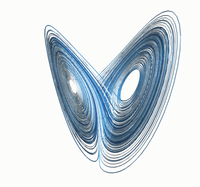 Figure left: The Lorenz system is a system of ordinary differential equations (the Lorenz equations) first studied by Edward Lorenz, 1960s. It is notable for having chaotic solutions for certain parameter values and initial conditions. In particular, the Lorenz attractor is a set of chaotic solutions of the Lorenz system which, when plotted, resemble a butterfly or figure eight form.
Figure left: The Lorenz system is a system of ordinary differential equations (the Lorenz equations) first studied by Edward Lorenz, 1960s. It is notable for having chaotic solutions for certain parameter values and initial conditions. In particular, the Lorenz attractor is a set of chaotic solutions of the Lorenz system which, when plotted, resemble a butterfly or figure eight form.
Read more: http://www.referenceforbusiness.com/management/Bun-Comp/Chaos-Theory.html
As an example, lets take another look at the flow of a stream presented below. The form, flow and change in the water patterns are constantly emerging based on and within the parameters (influential patterns and determinates) of the environment of which it flows through (the river bed, gravity, rocks, wood, etc.) and the composition, temperature and other determinates of the water itself (H2O, 70°F, amount). (parameters; any factor that defines a system, it purpose and determines its performance to that purpose.)

The purpose of the stream’s water flow is based on its current influencing patterns and determinates which shape its form. The purpose of this stream’s form is to drain the water from higher elevations based on gravity (a determinate factor).
This form also creates another purpose which is to create and give life to a healthy, natural ecology of nature along the stream. These two purposes are directly related to the form of the flow and patterns of the water guided by its own composition and its environmental parameters and determinates (the stream bed, gravity, temperature, etc.).
But if one thoughtfully guides and creates a different form to channel that emergent flow of energy and patterns, the purpose is changed.
For example if that water goes through a grain mill water wheel to turn an axle that eventually grinds wheat grain to produce wheat flour, then that novel form of flow within new parameters has a different purpose – to grind wheat into flour to make food like bread.
Thus…
“Out of chaos emerges form.”
“Out of complexity emerges simplicity through form.”
“Out of form emerges purpose.”
‘On Emergent Change – Patterns To Form’, Patrick Trottier, 2012)
On Organizational Form, Purpose and Performance.
“Organizations perform exactly like they are designed to perform.” (P. Trottier, sometime in the early 1990s)
It is interesting that the word ‘perform’ is created by the definitions of two words:
- ‘per’: ‘by means of’.
- ‘form’; ‘a particular mode and form in which something is ‘manifested’, an ability to perform.
How about that!
Thus, how an organization emerges, and what forms it takes, manifests its actual purpose and its performance.
Again, by the term ‘form’, we are NOT limiting ‘organizational form’ to such an old term such as ‘structure’. We are talking about ‘a whole system’ which includes behaviors, perceptions, capabilities, norms, finances, policies, practices, technologies, relationships, environmental influences, systems, structures, compensation , rewards, decision-making processes, power dynamics, and some may call this gestalt an ‘organizational culture’.
Often times, the actual form of an organization does not emit, or manifest, its desired purpose but does emit its actual purpose.
As an example, a hierarchical form, inherent within itself, has a purpose of control and predictability (actual purpose) although the desired purpose may call for adaptability, innovation and natural, fluid, emergent change simply because the organization is vesseled in environments that call forth constant, changing patterns. Obviously, the organizational form (actual purpose) does not ‘fit’ with its complex and rapidly changing internal and/or external environments.
Now, let us say that Sr. people are perplexed that their organization, having an organizational form that emits ‘control and power’, is not achieving their desired goals and thus complain that their organization and the people involved are not working well together, are not innovative, are not effectively performing, are dysfunctional to the demands of changing environments, and management does not understand what is happening.

Well, EODC™ says that their organization is functioning exactly as it is designed to function and serves its purpose of ‘control becoming dysfunctional’ because there is a big gap in the ‘fit’ between the form which manifests its ‘actual’ purpose and levels of performance and the demands of that organization’s internal and external environments. There is actually a ‘message’ here to management from the performance results of this lack of ‘fit’ and congruence, and this ‘message’ needs to be attended to.
Now, lets say that people working in another organization describe their experience as ‘craziness’, disconnected, stressed-out, and generally dysfunctional, Well, EODC™ says that organization is functioning exactly as it is formed to do and the actual purpose of that organization is explicitly formed to drive people crazy, loose good people, loose customers and be generally dysfunctional – no matter what the desired purpose is, or whatever Sr. Management says or wishes.

Thus, the essence of that organization and its actual purpose IS to drive people crazy. It is doing its job as an organization because it has been formed to do that.
As another example of ‘form emits purpose’ is ‘racing cars’. Cars have different types of ‘forms’ and a unique car form defines its purpose. Drag racers have a unique form which emits a unique purpose to race on a quarter mile tack. A NASCAR ‘form’ emits a different purpose; to race a different type of race on a 300 – 500 mile track.
A different form manifests a different purpose:

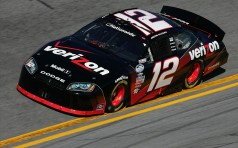
Other types of ‘organizational forms’ manifest the purpose of being more adaptable, natural and fluid.
Network ‘forms’ manifest such a purpose of being more adaptable, natural and fluid which is much different than the static, traditional hierarchical structures whose purpose is ‘to control and predict’. Organizations are always shifting to deal with things, and to get things done.
The following are three basic ‘network forms’:
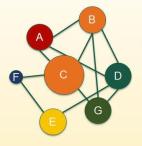


- The diagram to the upper left can be called a ‘functionally intact network’, or ‘a monomorphic network’.
- The diagram in the upper middle can be called a ‘functionally integrated network’ but is still mainly a monomorphic network.
- The diagram to the upper right can be called a ‘metamorphic network’. Metamorphic networks can ‘bring in’ different internal organizational functions and external associations as well as releasing existing functions depending on the need and focus of its ‘purpose’, thus continually changing its form and functionality. (‘metamorphic’; characterized by or exhibiting a change in form or character; relating to polymorphism, able to have several shapes or forms.”
The ‘metamorphic network’ (my term) GIF above right, is displayed with permission from a 21st Century information display ‘Michelangelo’ named Skye Bender-deMall. You can view his work at http://skyeome.net/ .
Actually, how we display organizations as hierarchies is not organizational reality at all.
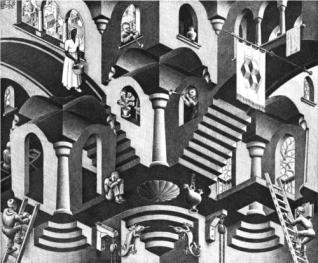
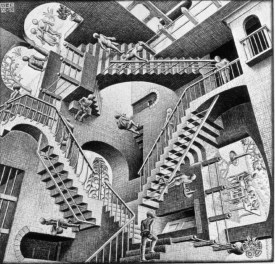
The Assumed Organization Reality
The assumed organization – static, predictable, control through structure and where up is up and down is down.
Then, there is organizational reality – moving, unpredictable, chaotic, complex, where up is down and down is across and adaptive, where fluid forms emerge (hopefully).
“We (Deloitte) just launched one of the world’s largest studies of people challenges in business, Deloitte Human Capital Trends 2016, and the results were striking. Among the 7,000+ companies who responded (in over 130 countries), the #1 issue on leaders minds is “how to redesign our organizational structure” to meet the demands of the workforce and business climate today.
Our conclusion, after almost a year of study, is that today’s digital world of work has shaken the foundation of organizational structure, shifting from the traditional functional hierarchy to one we call a “network of teams.” This new model of work is forcing us to change job roles and job descriptions; rethink careers and internal mobility; emphasize skills and learning as keys to performance; redesign how we set goals and reward people; and change the role of leaders.”
(http://joshbersin.com/2016/03/the-new-organization-different-by-design/)
The Ten Deloitte Global Human Capital Trends for 2016

From Hierarchies to Networks
The following diagram below is a depiction of trends in organizational concepts of the future.
We agree that the traditional hierarchical silos of the past 150 years do not work well in chaotic, complex worlds no matter how hard management practices try to control that which cannot be controlled. As the world becomes more complex, organizations need to structure themselves more along the lines of interconnected, functionally integrated, collaborative, value-driven network forms aligned to some amalgamation of reporting and accountability systems.
Organizations need to have the capabilities to create the conditions to continually influence, adapt and organize in line with changing emergent patterns in one’s internal and external environments.
Moving hierarchical, siloed organizations toward interconnected, functionally integrated, collaborative, value-driven network forms.
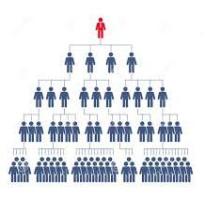
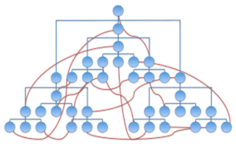
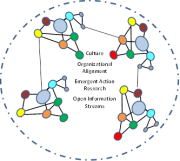
Traditional / Current Across / Current Integrated Networks
Through the processes of EODC®, we help traditional, hierarchical, siloed organizations of The Industrial Age move to The Interconnected Age of functionally integrated, collaborative, value-driven network forms aligned to an overall strategic and operational focus, and an amalgamation of reporting and accountability systems.
Through this transformation, EODC® helps any organization to gain the capability to continually influence, adapt and organize in line with changing emergent patterns in one’s internal and external environments.
Organizational Alignment And Network Forms
With fluid organizational forms such as emergent, collaborative, value-based networks, there are four main organizational elements and processes that align and connect the organization under the same umbrella:
- Emergent Organizational Alignment (EOA)
- A Living Culture
- Open, Integrated Information Streams
- Emergent Action Research
On Emergent Organizational Alignment (EOA) and Emergent Strategies To Achieve Goals
Emergent Organizational Alignment (EOA) occurs when the organization as a whole system continually translates and transforms high level strategic goals, objectives and strategies into functionally integrated operational goals, objective and strategies. This EOA process and the integration of strategic and operational goals, objectives and strategies continually aligns the whole organization.
The key is to have continuous, open feedback systems and the capability to be able to effectively shift one’s assumptions, beliefs and perceptions, as well as one’s goals as new information emerges from both internal and external environments.
In addition, strategies to achieve goals are always emerging as things change along the implementation process, thus emergent feedback systems and EAR continually facilitates the shaping of strategies to help the achievement of any goal.
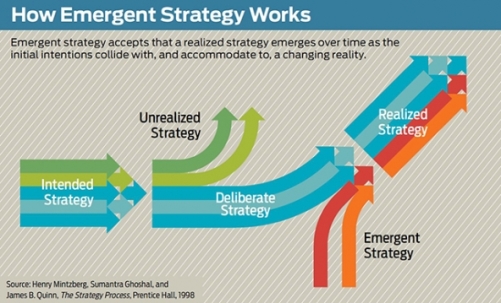
On Strategic Drift
Descriptions;
“Strategic drift is a critical concept within the realms of Strategic Management. Strategic drift usually occurs when organizations are unable to keep pace with the changes that happen in their immediate environment which in turn leads to their slow and gradual demise.”
“Strategic drift occurs when strategies fail to address the strategic position of the organization and performance deteriorates. It occurs when a company, even one that has enjoyed considerable success, responds far too slowly to changes in the external environment and continues with the strategy that once served it very well. Also, when companies base their development on cultural and historical influences and on their past …”
strategicdriftarticle-140723093644-phpapp02
Simply, strategic drift occurs when strategic planning strategies become ‘locked in’ and organizations are unable to deal with emergent change.
======================================
Closing Remarks
A methodology and an applied approach to EODC® will emerge from:
- The basic ‘principles and concepts’ to emergent change and EODC®,
- The ‘conditions’ that influence and facilitate emergent change in people and organizations, and
- The theorems, constructs, research and practices with clients accumulated and learned from over the last 20 plus years.
Stay tuned…. (it is now 2012)
OK, here is the methodology and an applied approach to EODC®: (it is now 2017)
The Emergent Organizational Development and Change (EODC)® Platform
The EODC® Platform co-creates the conditions within an organization so emergent change becomes apparent, is influenced more fluidly and naturally, and ‘change’ itself is viewed and experienced as a normal, continuous, emergent, real-time process.
Simply, the EODC® Platform creates ’emergent organizations’.
Link: https://goo.gl/7jiOo4
=====================================
OK, coming to an end here…
For more detailed information and description regarding certain aspects of EODC®, please explore the list of write-ups along the right column of these pages, especially the link to; https://globaltransforming.wordpress.com/2015/06/30/emergence-in-organizations/.
This list will continue to expand as we explore and put ‘ideas to pen’ in regards to certain critical elements and conditions deemed necessary for organizations to continually emerge into novel ‘forms’ of organizational diversity needed for the 21st Century.
In line with the spirit of emergence itself, the ideas, thoughts and write-ups within this forum will also continually emerge.
I have trademarked Emergent Organizational Development and Change (EODC)® solely to protect its integrity. I do not want what happened to OD in its dilution where OD became anything and everything in the 1990s.
All comments, ideas, challenges, and diversity of thought are welcomed.
I hope you have gotten something out of this post.
I also welcome you to join me in this quest.
I am still learning.
About EODC®
Through the approach of EODC®, we help traditional, Industrial Age hierarchical siloed organizations move to The Interconnected Age of Collaborative Networks.
EODC® is a functionally emergent, integrated, value-driven ‘business strategy’ so the organization itself can manifest new ways of doing things aligned to an overall living vision, living values, a living culture, and an integration of open IT/IS/AI information and performance systems to co-create a strategic / operational focus, a great place to work, and, of course, business results.
Through this transformation, EODC® helps any organization to gain the capability to continually influence, emerge and organize in line with rapidly changing emergent patterns, and greater complexity in one’s internal and external environments.
Reference
1. (Baskerville, R., Travis, J., and Truex, D.P. Systems without method: The impact of new technologies on information systems development projects. In K.E. Kendall, K. Lyytinen, and J.I. DeGross, Eds., Transactions on the Impact of Computer Supported Technologies in Information Systems Development. Elsevier, Amsterdam, 1992.)
© Patrick Trottier and Associates, 2012 (All rights reserved)
Registered Trademarks, and Trademarks (2017):
The Institute Of Emergent Organizational Development and Emergent Change®(EODC®)
Emergent Organizational Development and Emergent Change®(EODC®)
Emergent Organizational Development® (EOD®)
Emergent Change®
Emergent Organizations™
Emergent Leadership™
Emergent Action Research™

I find this blog fascinating. So much of the content and examples resonate with me and the work I do, it’s great as a reminder and a reassurance that I am approaching problems and programmes sensibly! Thank you for sharing your wisdom.
I chanced upon your Blog while writing my own, and found it very interesting! Your approach to analyzing the change in organizations is pretty unique. The posts are quite thought-provoking!
Thanks designed for sharing such a nice idea, post is
pleasant, thats why i have read it fully
Very true
Fascinating ideas. Looking forward to learning more and reading more posts!
I am still digesting everything I’ve read here so far. I find them very interesting, educational, thought-provoking and appropriate for today’s various business organizations.
Just curious (and I may have missed it somewhere), how would something like a salary and ranking structure fit into an emergent organization or an organization that seems to be evolving into one with integrated networks instead of the usual hierarchical structure?
Thank you and looking forward to more from emergent organizations!
Yrreg – a good question. Obviously, each organization would develop and continually emerge their own ‘salary and ranking structure’. Generally, with organizations I have worked with, the core principle is ‘to recognize individual contributions’, specified ‘attributes’, and merit. Here is a pretty good outline for such, although it is a general outline and can be formed to fit both the culture, and well as different network forms. https://slideplayer.com/slide/9151564/
Evaluation would be based on ‘value’, range of accountability, performance including ‘collaboratory attributes’, etc., and based mostly on ‘peer review’. For example, a person within an integrated function within a network hub taking a lead role for a time would increase their accountability scale for that time, how well they led and facilitated collaboration (an example), as well as business results achieved regarding specs., budget and ‘on time’. This is a simple example. I hope this gives you a small idea in regards to your question.
Delighted to see these thoughts materialize.
I find this website to be informative- unique- innovative- and even entertaining. The concepts and ideas presented have been really worth my time spent. EODC seems to be ’emerging’ as a singular and creative process for so many organizations – large and small……congrats !
Thanks Zoraida. Your words mean very, very much to me. It is risky to ‘put one’s ideas out there’ as an accumulation of 40 years of thought and practice. We all need encouragement and, for one, I certainly do. To all those who explore the ‘unknown’, I salute you.
Thank you Zoraida… very much appreciated…
Patrick